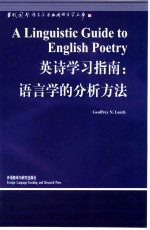图书介绍
英诗学习指南 语言学的分析方法 英文版PDF|Epub|txt|kindle电子书版本下载

- (英)Geoffrey N.Leech著;秦秀白导读 著
- 出版社: 北京:外语教学与研究出版社
- ISBN:7560024297
- 出版时间:2001
- 标注页数:249页
- 文件大小:11MB
- 文件页数:290页
- 主题词:英语(学科: 诗歌 学科: 文学语言 学科: 研究) 英语 诗歌 文学语言
PDF下载
下载说明
英诗学习指南 语言学的分析方法 英文版PDF格式电子书版下载
下载的文件为RAR压缩包。需要使用解压软件进行解压得到PDF格式图书。建议使用BT下载工具Free Download Manager进行下载,简称FDM(免费,没有广告,支持多平台)。本站资源全部打包为BT种子。所以需要使用专业的BT下载软件进行下载。如BitComet qBittorrent uTorrent等BT下载工具。迅雷目前由于本站不是热门资源。不推荐使用!后期资源热门了。安装了迅雷也可以迅雷进行下载!
(文件页数 要大于 标注页数,上中下等多册电子书除外)
注意:本站所有压缩包均有解压码: 点击下载压缩包解压工具
图书目录
INTRODUCTION1
0.1 The ‘lang.-lit.’problem1
0.2 A descriptive rhetoric3
0.3 Poetic language and ‘ordinary’language5
0.4 A possible misgiving6
Notes7
1.1 Varieties of English usage8
1.1.1 Dialects8
1 POETRY AND THE LANGUAGE OF PAST AND PRESENT8
1.1.2 Registers: usage according to situation9
Preface by Halliday F12
1.2 Linguistic convention in poetry12
王宗炎序 F13
1.2.1 The trend of conformity13
1.2.2 The function of archaism14
1.2.3 Poetic language and poetical language15
Preface by Chomsky F16
1.2.4 Grand, middle, and plain styles16
1.2.5 The routine licences of verse composition17
Examples for discussion19
Notes22
沈家煊序 F23
2 THE CREATIVB USE OF LANGUAGB23
2.1 The escape from banality23
2.2 Two meanings of creative24
2.3 The qualities of prose in poetry25
导读 F26
2.4 Degrees of linguistic audacity29
Examples for discussion33
Notes35
3 VARIETIES OF POETIC LICENCE36
3.1 Anatomy of language37
3.1.1 Three main levels: realization, form, semantics37
Foreword F37
3.1.2 Phonology and graphology39
3.1.3 Meaning and significance39
Preface F39
3.1.4 Ancillary branches of linguistics40
Acknowledgments F41
3.2 Types of deviation42
3.2.1 Lexical deviation42
3.2.2 Grammatical deviation44
3.2.3 Phonological deviation46
3.2.4 Graphological deviation47
3.2.5 Semantic deviation48
3.2.6 Dialectal deviation49
3.2.7 Deviation of register49
3.2.8 Deviation of historical period51
3.3 Conclusion52
Examples for discussion53
Notes54
4 FOREGROUNDING AND INTERPRETATION56
4.1 Foregrounding56
4.1.1 Foregrounding in art and elsewhere56
4.2 Interpretation58
4.1.2 An example58
4.2.1 The subjectivity of interpretation59
4.2.2 The warranty for a deviation61
4.3 Parallelism62
4.3.1 Parallelism as foregrounded regularity62
4.3.2 How much regularity?64
4.3.3 Patterns of identity and contrast65
4.3.4 The interpretation of parallelism67
Examples for discussion69
Notes71
5 VERBAL REPETTTION73
5.1 Schemes and tropes74
5.2 Formal repetitions76
5.2.1 Free verbal repetition77
5.2.2 Types of verbal parallelism79
5.2.3 The functions of verbal parallelism84
Examples for discussion86
Notes88
6 PATTERNS OF SOUND89
6.1 Sound patterns within syllables89
6.2 Sound patterns in relation to stress91
6.3 Music in poetry93
6.4 The interpretation of sound patterns95
6.4.1 Chiming95
6.4.2 Onomatopoeia96
6.4.3 Varieties of onomatopoeia97
Examples for discussion100
Notes102
7 METRE103
7.1 Rhythm and metre103
7.2 The rhythm of English104
7.2.1 The measure: the unit of rhythm106
7.2.3 Pauses107
7.2.2 Which syllables are stressed?107
7.2.4 Syllable length108
7.3 Metre and the line of verse111
7.3.1 English metre as rhythmic parallelism111
7.3.2 The foot of traditional prosody112
7.3.3 The line of verse114
7.3.4 Some numerical aspects of metre115
7.3.5 Accentual metre118
7.4 The interaction of rhythm and verse form119
7.4.1 Defeated expectancy119
7.4.2 Metrical variation121
7.5 Grammar and metre122
7.5.1 Enjambment123
7.5.2 The verse paragraph125
For discussion128
Notes128
8 THE IRRATIONAL IN POETRY131
8.1 A logical view of meaning131
8.1.1 Some types of semantic oddity131
8.1.2 Definition and description134
8.2 Redundancy in poetry136
8.2.2 Tautology137
8.2.1 Pleonasm137
8.2.3 Periphrasis138
8.3 Absurdity in poetry140
8.3.1 Oxymoron140
8.3.2 Paradox142
8.4 Beyond reason and credibility143
Examples for discussion144
Notes146
9 FIGURATIVB LANGUAGB147
9.1 Transference of meaning148
9.1.2 Metaphor150
9.1.1 Synecdoche150
9.1.3 Metonymy152
9.2 Aspects of metaphor153
9.2.1 How to analyse a metaphor153
9.2.2 Simile and metaphor156
9.2.3 Notional classes of metaphor158
9.2.4 Extended metaphor159
9.2.5 Compound metaphor and mixed metaphor159
9.2.6 Symbolism and allegory161
Examples for discussion164
Notes165
10 HONEST DECBPTIONS166
10.1 Hyperbole and litotes167
10.1.1 Hyperbole167
10.1.2 Litotes or rhetorical understatement168
10.1.3 The uses of hyperbole and litotes170
10.2 Irony171
10.2.1 The mask of irony171
10.2.2 Irony and metaphor173
10.2.3 Innuendo174
10.2.4 Irony of tone176
Examples for discussion179
Notes182
11 IMPLICATIONS OF CONTEXT183
11.1 Licences of situation184
11.1.1 Rhetorical question184
11.1.2 Apostrophe185
11.1.3 Routine licences of situation186
11.2 The given situation187
11.3 The world within the poem189
11.3.1 The introduction of inferred situations191
11.3.2 Words of definite meaning193
11.3.3 Fact and fiction195
11.3.4 Impossible situations197
11.4 Situation and action199
11.5 Conclusion201
Examples for discussion202
Notes204
12 AMBIGUITY AND INDBTERMINACY205
12.1 Kinds of ambiguity205
12.2 Puns and word-play209
12.2.1 Technical variations210
12.2.2 In defence of the pun212
12.3 Open interpretation214
12.3.1 Sources of multiple and indeterminate significance215
12.3.2 The analogy of visual arts217
12.3.3 Seeking the optimal interpretation220
Examples for discussion221
Notes223
CONCLUSION225
Notes227
Suggestions for Further Reading229
General Index233
Index of Sources of Examples for Discussion239
文库索引241